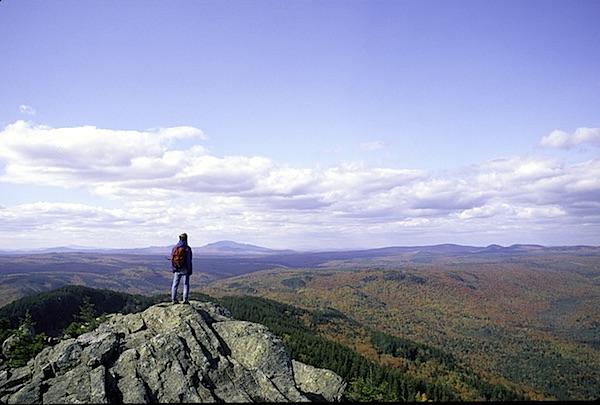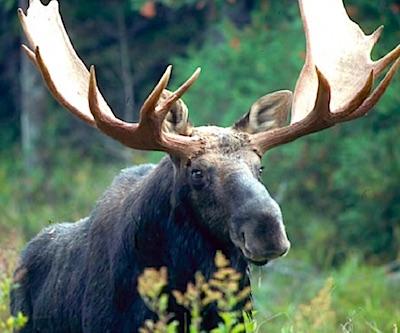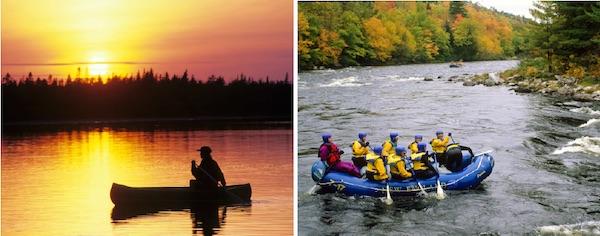
A hiker atop Borestone Mountain gazes into a potential national park in Maine/George Wuerthner
Maine isn't all rocky coastlines. Travel to the Pine Tree State's interior and you'll find a mythical, verdant, forested woodland of hemlock and balsam that inspired Henry David Thoreau's treatise, The Maine Woods.
"Every creature is better alive than dead, men and moose and pine trees, and he who understands it aright will rather preserve its life than destroy it," wrote Thoreau in expressing his concern for the future. "The mission of men there seems to be, like so many busy demons, to drive the forest out of the country.'
Under vast stands of ancient trees there are many shades of green, giant mushrooms, and mattress-soft patches of moss. The forest is so dense in places that just small shafts of sunshine penetrate and illuminate the ground, almost like spotlights. Occasionally, a moose will amble in and out of the timber, its domain embracing countless hidden lakes and streams that dot the woodlands.
The forest seems timeless.
But these woodlands have also been where families found their livelihoods for generations. They affectionately call it their 'wood basket,' where outdoorsmen, loggers, anglers, and hunters work and play. But now the woods are in conflict. Traditional users and preservationists debate the merits of a proposed national park and recreation area. The original national park proposal of the 1990s was huge; more than 3 million acres, nearly a third of Maine's Great North Woods. It envisioned one of the country's largest national parks, larger by almost a third than Yellowstone National Park. This plan was not well-received. Opponents were especially critical of millionairess Roxanne Quimby, who was donating 150,000 acres of her own lands towards a park.
Quimby is co-founder of Burt's Bees, whose honey-based lip balm and other personal care products made her a millionaire many times over. After selling the company, she has applied her wealth to conserve Maine landscapes.
But now a smaller plan is seeing more support from the locals. The current Katahdin Woods and Waters National Park and National Recreation Area proposal is just 5 percent as large as the first plan, would offer a blend of allowed activities and, according to proponents, involve less than 1 percent of the state's timber resources.
Just two hours from coastal Acadia National Park, the proposed park abuts Baxter State Park and has spectacular views of Mount Katahdin, the northern terminus of the Appalachian National Scenic Trail.
Quimby is prepared to donate 75,000 acres along the East Branch of the Penobscot River for the park, and another 75,000 acres for a national recreation area along its west bank. The national recreation area might help sooth local opinion as it could be open to hunting, fishing, and snowmobiling.
Quimby's son, Lucas St. Clair, has become its primary advocate. St. Clair is the president of Elliotsville Plantation Inc. (EPI), a company created to manage the land. (The entity's name comes from the unorganized township where Ms. Quimby first purchased lands with an eye on conservation.)

Maine's North Woods is a sanctuary for wildlife and wild lands dotted by lakes and threaded by rivers/George Wuerthner
St. Clair's grassroots approach has brought the boil back down to a simmer. He spends much of his time hunting and fishing in these very woods and discussing the proposal with proponents and opponents alike.
'We've been able to hear voices from people that are greatly affected by the outcome of this and we've been able to shape the proposal to meet the cultural and historical heritage of the region so that it really enhances what is here already as opposed to creating something that has never existed in the past,' he says.
Some opponents say the National Park Service can't manage what it already owns, and they are also wary of the federal government. During a park informational meeting in March, locals questioned the park's economics. Lincolnville resident and Friends of the Maine Woods member Andrew Young was quoted in the Bangor Daily News, as saying, 'The economic numbers do not make sense. This park will not happen. There is no money to make it happen.'
Against that view, however, St. Clair and his mother have pledged to raise a $40 million endowment for the proposed park; half would come from Ms. Quimby, and the other half from a matching campaign.
At the same time, hundreds of business owners have voiced support, saying a national park would be good for the economy as it would bolster the tourism sector and showcase a part of Maine that has been overshadowed by the state's coastal amenities and attractions.
While national park status is the nation's highest level of protection, the designation can carry some baggage. National parks may bring in tourism dollars, create jobs, and set high conservation standards, but they can also impose stricter environmental standards on surrounding industries, set restrictions on heavy recreational usage, and lure low-paying jobs.
And yet there's recognition that logging is no longer the economic stalwart it once was.
David Farmer, an EPI spokesman, concentrates upon the positive.
'It's not an either/or,' he says. 'We do not see this as competition. Industry and the national park can co-exist.'
Proponents, noting that Acadia is one of the country's top-ten visited parks, believe that a park in Maine's interior would further burnish the state's status as a tourism destination.
'An inland park would really complement the highly-toured coastline park,' says Farmer. 'This would allow tourists to move inland after a visit to Acadia for a more holistic look at the cultural, educational, and recreational experiences centered on Maine's woodland heritage.'
As mills close and young people move away in search of jobs, there's a growing sense that something needs to change for the state's economy.

From peaceful backcountry paddling destinations to thrilling whitewater adventures, Maine's North Woods offers an array of recreational opportunities/George Wuerthner
Gail Sanjoy, president of the Katahdin Chamber of Commerce, says, 'The proponents of the national park don't believe that the national park standing alone will be our area's savior, but it will go a long way from where we are today. We need to explore all options, and keep all options on the table, and the national park happens to be the offer on the table right now.'
In March the Bangor City Council voted 7-2 to support the concept of a national park, joining the towns of Millinocket, East Millinock, and the Penobscot Indian Nation. In late March, more than 200 Maine business owners sent a letter of support to their congressional delegation, which has not as yet supported the concept, choosing to listen to their constituents. But it's obvious that support is growing.
Proponents see the land and its endowment as an incredible gift at a time when economic options are limited, and feel something needs to be done. For others, these woods are their home, which contribute much more than hiking trails for the occasional tourist.
Miri Gubler spent the spring semester as an editorial intern with the Traveler. She previously has written about Acadia National Park and California condors



Comments
Making the North Woods a National Park might bolster some towns' local economies but it wouldn't be good for the North Woods.
What about private property rights, EC? As I understand it, all the land for the proposed park would come from Ms. Quimby.
Curious to see some elaboration from EC as well. The article seemed to suggest the opposite. I am not familiar with the local politics of Maine. Looking forward to a more thorogh response.
Kurt,
Didn't say she didn't have the right to give her property or money away. Just saying it wouldn't be good for the North Woods to make it a National Park.
So perhaps you could explain why turning private property, which could in theory be sold for logging or development, into a national park, would not be good for the North Woods?
Because the alternative isn't to log and develop. She could put it into a land trust and let it sit as it is. Creating a magnet to draw more people with more infrastructure would not be good for the Woods. Admittedly this is a small area but the natural tendency would be to attempt to expand. Not to mention the additional burden on the NPS system.
Well, it would be a burden on the NPS, granted. That's Congress's fault.
But I think it could be a rich resource for science, introducing generations to a unique ecosystem, and encouraging healthy outdoor activities. Parks have the unique ability to do all three. I'm not sure lands in trusts do...particularly when trusts shut off public access.
As for "more infrastructure," you look at the landscapes of places such as Yellowstone, Glacier, Big Bend, even Shenandoah, and that aspect can certainly be controlled if not prevented outright. The establishment of Shenandoah was even good for the health of the Blue Ridge there in Virginia.
I definitely understand what EC is saying, and I tend to agree with some of his statements, but I still support seeing another large scale National Park on the scale of some of the western parks being created in the Eastern US. This is one of the last best areas this can be done, and it should be done. Large scale natural areas are a diminishing commodity in this country, and we should do whatever we can to protect what's left. However, I prefer more parks are created similar to how North Cascades was created, in that development of it is vastly limited, and the wilderness act is quickly applied. Unfortunately in this case, i'm not sure this could happen. It would have to become a park first, because it's currently not public lands. But, I do favor the opinion that development of the protected area should be vastly limited inside the National Park boundary. Meaning close some dirt logging roads, turn other dirt roads to trails, and attempt to minimize homo sapien consumaticus from devouring what's left of the area. If they turn this into a park, than build 50 paved roads to every overlook and unique feature in the forests ecosystem, then it's better off being left in something like the nature conservancy. North Cascades National Park should be the model for every new National Park with a large scale natural and scenic area.